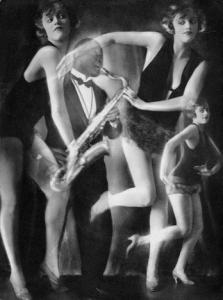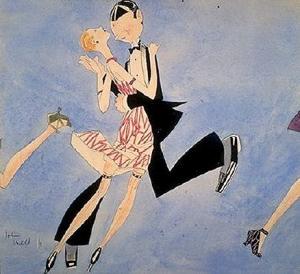- Historical Dance
- Jazz Age Social Dancing ("The Modern Dances")
- 0. The Essentials of Jazz Age Ballroom Dancing
- 1. Foxtrot Part 1: The Jazz Age Foxtrot
- 2. Youth Dancing in the Jazz Age
- 3. The Jazz Age Waltz
- 4. The Jazz Age Tango
- 5. 1930s Rumba
- 6. 1930s Samba
- 7. 1930s Conga
- 8. Bal Musette: Parisian Dance of the Jazz Age
- 9. Dancing in Weimar Berlin
- Dancing Made Easy - 1922
- Film Library - Jazz Age Dance
- Historical Dance Films posted to Pinterest
- Jazz Age Dance - Apologia
- Jazz Age Dance Image Collection
- Jazz Age Lead and Follow
- Places to Dance in Southern California in the Jazz Age
- Sampler of Jazz Age Dance Holds
- The Pathé Historical Dance Collection: 1920s-40s
- Ragtime Dance - the One Step
- Regency Dance
- Victorian Dance
- Jazz Age Social Dancing ("The Modern Dances")
2. Mid 1920s - The Charleston Era
 Emerging around 1923, the Charleston was a ground-breaking dance in its time. It was enthusiastically embraced by the youth of the Jazz Age, who found in it an outlet for their desire for novelty, exuberance and a total break with the social constraints of the past. It was also revolutionary in its strong solo elements, where a dancer would perform without a partner, or physically separated from a partner, in a way that was quite a revelation for the white dancers of the early 20th Century.
Emerging around 1923, the Charleston was a ground-breaking dance in its time. It was enthusiastically embraced by the youth of the Jazz Age, who found in it an outlet for their desire for novelty, exuberance and a total break with the social constraints of the past. It was also revolutionary in its strong solo elements, where a dancer would perform without a partner, or physically separated from a partner, in a way that was quite a revelation for the white dancers of the early 20th Century.
In the heady days of the Roaring '20s, it even made occasional forays into the dancing of adventurous minded adults in a way that later youth dances did not. In 1926, you might have seen a 35 year old succumbing to an occasional fit of Charleston. In 1936, was far less likely you would have seen a 35 year old dancing a Lindy Hop.
There are a few widespread notions about the Charleston that I hope you can, if you happen to entertain these notions, set aside while reading this.
Charleston Misconceptions
- Charleston was the dominant dance of the Jazz Age
- The Charleston was nearly always danced solo or with a couple doing individual solos in the vicinity of one another
- The Charleston was defined by a small set of specific steps. If you didn't do those steps, you weren't doing a Charleston
The Charleston Reality
The term "Charleston" persisted through the '20s and into the early '30s, though the definition of what constituted a "Charleston" was a bit muddy from the start and got even more vague as it evolved. The term was used indiscriminately as a catch-all for any sort of energetic, jazzy, showy solo or couples dancing, even though the more "canonical" moves we usually associate with Charleston gradually fell out of fashion; and moves looking much more like later Swing made their way in (See the video at the bottom of this page for what I mean by the "canonical" moves). It was even applied to a pretty tame Fox Trot variation called the "Crawl Charleston".
Be sure to check out the "Charleston Contest" on the "Collegiate" page in this series. Not Charleston in the sense we usually think of it.
Numerous variations popped up through the '20s, often accompanied with statements about how the Charleston had been displaced by the Black Bottom, Shimmy or what ever. While these "new" styles included a few signature moves, they were not essentially different, and the film evidence I have seen suggests that dancers simply danced the dances they danced, and did not worry about whether a particular step fell into one camp or the other. Fashions changed, and styles evolved, but clear breaks and definitive taxonomies are elusive. (More about the Black Bottom)
I would also assert that, while it was popular among a jazzier and younger set during the '20s, it never displaced the total dominance of the Fox Trot, even among the kids, who loved to kick up their heels, but still preferred to spend most of their dancing time holding their partners close. It was a variation, a diversion, a liberating moment of madness; but it was never the only dance of the evening, even when when the Jazz band was running hot. The more social aspects of the simple and intimate Fox Trot ensured its preeminent place at the top of the dance hierarchy.
The Solo Charleston
The solo Charleston was, more than anything else, the signature dance of the flapper: a dance for a liberated woman to say "Look at me! I'm free, beautiful and sexy!". It was sometimes danced on top of a table, while all the guests (especially the men) cheered her on. Joan Crawford in "Our Dancing Daughters" does what I like to think of as the definitive solo Charleston, starting out on a table, then moving to the dance floor where she does a wild series of high kicks and shimmies. Her skirt is a bit too confining, so off it goes and she dances in her undies and flying fringe. Most of her footwork does not fit definitively into any specific style, but is mostly along the lines of exuberant, sexy, making-it-up jazzy dancing.
This set of clips from "Our Dancing Daughters" (a silent film) has been set to the modern "electro-swing" of Parov Stelar, but it includes the opening (implied) naked Charleston scene and the wild party Charleston scene that, I think, embody the wild spirit of the flapper.
The solo Charleston also created a revolution in the dancing of female cabaret performers and showgirls, who embraced a crowd-pleasing and risque new style, and then combined it with tap dancing, and often did it in unison with other scantily clad dancers to create the classic production numbers of the time.
The Partner Charleston
While the solo Charleston tends to get the most attention, more important in the social context was the partner Charleston. Sometimes it would be a man and a woman both doing, essentially, solo Charlestons together; but I don't think that was the most common way for two people to share a Charleston. Rather than spending three minutes kicking and spinning and wiggling in the general vicinity of one another, couples more often approached it as a sort of Foxtrot variation.
This could be the couple, in typical body-to-body Foxtrot position doing a restrained Charleston step or separated to arms length, doing the back-and-forth time step.
More common though was a pattern of Jazz Foxtrot for a while, then someone would break off and initiate a solo Charleston routine with the partner playing along, and then, when it seemed like they had done it enough, they'd resume their close hold and Foxtrot some more.
Here's a bit of what I am talking about from the 1926 film "Nickle-Hopper".
From the British, here's a more sophisticated approach. I note though that the "wrong" style in this clip looks very much like the illustration at the top of the page which comes from a cover of Fitzgerald's "Tales of the Jazz Age". It's wrong only in that the film maker disapproves of it. It was clearly a popular way to dance.
Finally, from the Pathe collection, here is a collection of some frequently used clips showing the most familiar of the couple and solo Charleston moves. There's an odd bit at the end with Rudy Vallee. You can skip that.
Next: Collegiate

